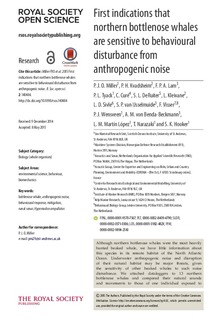| dc.contributor.author | Miller, Patrick J.O. | |
| dc.contributor.author | Kvadsheim, Petter Helgevold | |
| dc.contributor.author | Lam, Frans-Peter A. | |
| dc.contributor.author | Tyack, Peter L. | |
| dc.contributor.author | Curé, Charlotte | |
| dc.contributor.author | DeRuiter, Stacy | |
| dc.contributor.author | Kleivane, Lars | |
| dc.contributor.author | Sivle, Lise Doksæter | |
| dc.contributor.author | van IJsselmuide, Sander P | |
| dc.contributor.author | Visser, Fleur | |
| dc.contributor.author | Wensveen, Paul J. | |
| dc.contributor.author | von Benda-Beckmann, Alexander M. | |
| dc.contributor.author | López, L Martin | |
| dc.contributor.author | Narazaki, T | |
| dc.contributor.author | Hooker, S. | |
| dc.date.accessioned | 2016-01-18T15:45:19Z | |
| dc.date.accessioned | 2016-01-20T13:38:23Z | |
| dc.date.available | 2016-01-18T15:45:19Z | |
| dc.date.available | 2016-01-20T13:38:23Z | |
| dc.date.issued | 2015-06-03 | |
| dc.identifier.citation | Miller PJO et al. 2015 First indications that northern bottlenose whales are sensitive to behavioural disturbance from anthropogenic noise.R. Soc. open sci. 2: 140484. http://dx.doi.org/10.1098/rsos.140484 | nb_NO |
| dc.identifier.issn | 2054-5703 | |
| dc.identifier.uri | http://hdl.handle.net/11250/2374373 | |
| dc.description | - | nb_NO |
| dc.description.abstract | Although northern bottlenose whales were the most heavily hunted beaked whale, we have little information about this species in its remote habitat of the North Atlantic Ocean. Underwater anthropogenic noise and disruption of their natural habitat may be major threats, given the sensitivity of other beaked whales to such noise disturbance. We attached dataloggers to 13 northern bottlenose whales and compared their natural sounds and movements to those of one individual exposed to escalating levels of 1–2 kHz upsweep naval sonar signals. At a received sound pressure level (SPL) of 98 dB re 1 μPa, the whale turned to approach the sound source, but at a received SPL of 107 dB re 1 μPa, the whale began moving in an unusually straight course and then made a near 180° turn away from the source, and performed the longest and deepest dive (94 min, 2339 m) recorded for this species. Animal movement parameters differed significantly from baseline for more than 7 h until the tag fell off 33–36 km away. No clicks were emitted during the response period, indicating cessation of normal echolocation-based foraging. A sharp decline in both acoustic and visual detections of conspecifics after exposure suggests other whales in the area responded similarly. Though more data are needed, our results indicate high sensitivity of this species to acoustic disturbance, with consequent risk from marine industrialization and naval activity. | nb_NO |
| dc.language.iso | eng | nb_NO |
| dc.publisher | The Royal Society | nb_NO |
| dc.rights | Navngivelse 3.0 Norge | * |
| dc.rights.uri | http://creativecommons.org/licenses/by/3.0/no/ | * |
| dc.title | First indications that northern bottlenose whales are sensitive to behavioural disturbance from anthropogenic noise | nb_NO |
| dc.type | Journal article | nb_NO |
| dc.type | Peer reviewed | nb_NO |
| dc.date.updated | 2016-01-18T15:45:19Z | |
| dc.source.pagenumber | 11 s. | nb_NO |
| dc.source.journal | Royal Society Open Science | nb_NO |
| dc.identifier.doi | 10.1098/rsos.140484 | |
| dc.identifier.cristin | 1304514 | |

